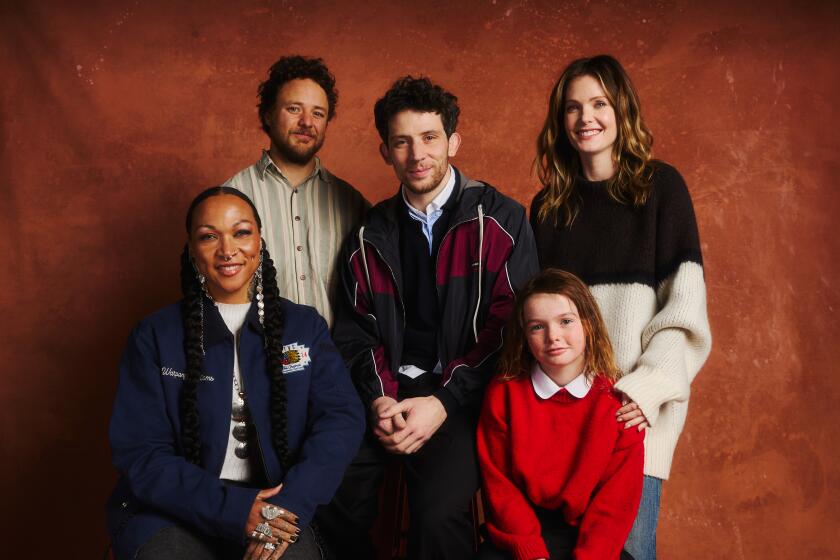Review: The bloody western ‘Let the Corpses Tan’ gives European B-movies a splattery salute
- Share via
“Let the Corpses Tan” — or, to use its even better French title, “Laissez Bronzer Les Cadavres” — is a feverish, obsessive act of cinematic rehabilitation, a shoot-’em-up conceived in tribute to a peculiar strain of blood-spattered B-movies from the 1960s and ’70s.
Adapted from a 1971 crime novel by Jean-Patrick Manchette and Jean-Pierre Bastid, it’s a gorgeous, nasty valentine to a bygone era of European crime thrillers and westerns, set over the course of a trigger-happy day for a gang of thieves hiding out on the Corsican coast.
In this, the movie marks a shift in genre (though not in time frame) for the Brussels-based directors Hélène Cattet and Bruno Forzani, who paid lurid and imaginative tribute to the Italian giallo horror tradition with their first two films, “Amer” (2009) and “The Strange Color of Your Body’s Tears” (2013).
Strange colors pop off the screen just as aggressively here — the palette is a riot of sizzling reds, blues, yellows and especially golds — and a few tears are shed too, though nowhere near as voluminously as the geysers of blood, the smears of paint and the occasional stream of urine. This is a picture that likes its splatter.
That much is apparent from the opening scene, a staccato frenzy of disorienting closeups in which a haughty artist named Luce (Elina Löwensohn) fires a series of bullets into a dripping-wet canvas. She paints, smokes and glowers from a stone compound on a craggy hill overlooking the Mediterranean, a location that is about to become a not-so-safe house for her and her various accomplices involved in a deadly roadway heist.
Returning to the compound with a large stash of gold bars, the conspirators include Luce’s lawyer and lover (Michelangelo Marchese), an alcoholic novelist called Max Bernier (Marc Barbé) and a couple of toughs aptly named Rhino (Stéphane Ferrara) and the Brute (Bernie Bonvoisin). But all plans for a perfect getaway are swiftly foiled, first by Bernier’s wife, Mélanie (Dorylia Calmel), who shows up unexpectedly with her young son (Bamba Forzani Ndiaye) and nanny (Marine Sainsily) in tow, and then by the arrival of two cops (Hervé Sogne and Dominique Troyes) who have barely set foot on the property before the bullets start to fly.
As the characters’ physical positions and emotional alliances shift, and blood begins to erupt from meticulously designed prosthetic wounds, you may long for a flow chart to help keep track of who’s shooting at whom and who’s on whose side, the spatial and temporal logistics of which frequently defy comprehension. But you might also suspect that, on some level, comprehension is beside the point. Even when the movie makes an attempt to explain itself — often by rewinding a series of events and replaying it from a slightly different perspective — it seems less interested in clarifying the moment than in drawing it out for its own sake.
Adapting someone else’s work for the first time may have forced Cattet and Forzani into a somewhat more coherent, streamlined narrative groove, but their work has lost none of its mad formal bravura. They attack their material like merry deconstructionists, splintering each action into its component parts; a gesture as simple as removing a pistol from its holster becomes a montage of rapid-fire steps, each shot amplified by precision-tooled sound design. Extreme closeups of eyes and mouths are par for the course, as rooted in the movie’s spaghetti-western DNA as its arid desert tones (captured on Super 16-millimeter film) and its brazenly borrowed Ennio Morricone music cues.
Just how much substance all this style ultimately amounts to will be very open to debate, particularly among viewers who are far less well versed in the specific genre traditions that Cattet and Forzani devote themselves to plundering. Which is not to suggest that “Let the Corpses Tan” requires an advanced degree in exploitation-cinema studies to follow or figure out. Unlike, say, Quentin Tarantino, whose pop thrillers are larded with showy and elaborate games of Spot the Reference, Cattet and Forzani attempt a less specific, more free-floating style of immersion.
Do they succeed? Perhaps that’s not the right question. Is it possible for a movie to hold your attention but not your interest? Can one admire the undeniable craft and skill with which the filmmakers attend to their specimen, even if — to apply a less generous reading of the title — they are essentially applying a fresh sheen of bronze to a cadaver? For much of “Let the Corpses Tan” we are watching two sides locked in a stalemate, and that seems a logical place to leave the argument. See it and decide for yourself whether it’s spectacular or spectacularly futile.
------------
‘Let the Corpses Tan’
(French dialogue with English subtitles)
(Not rated)
Running time: 1 hour, 32 minutes
Playing: Nuart Theatre, West Los Angeles
More to Read
Only good movies
Get the Indie Focus newsletter, Mark Olsen's weekly guide to the world of cinema.
You may occasionally receive promotional content from the Los Angeles Times.











